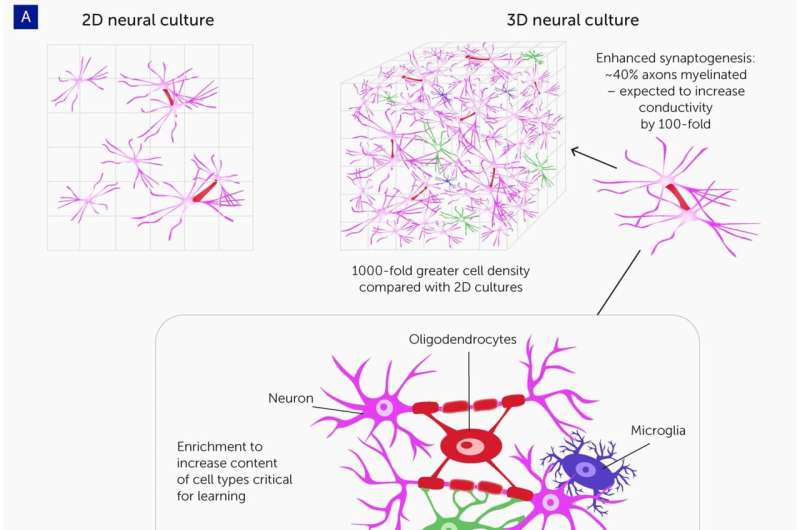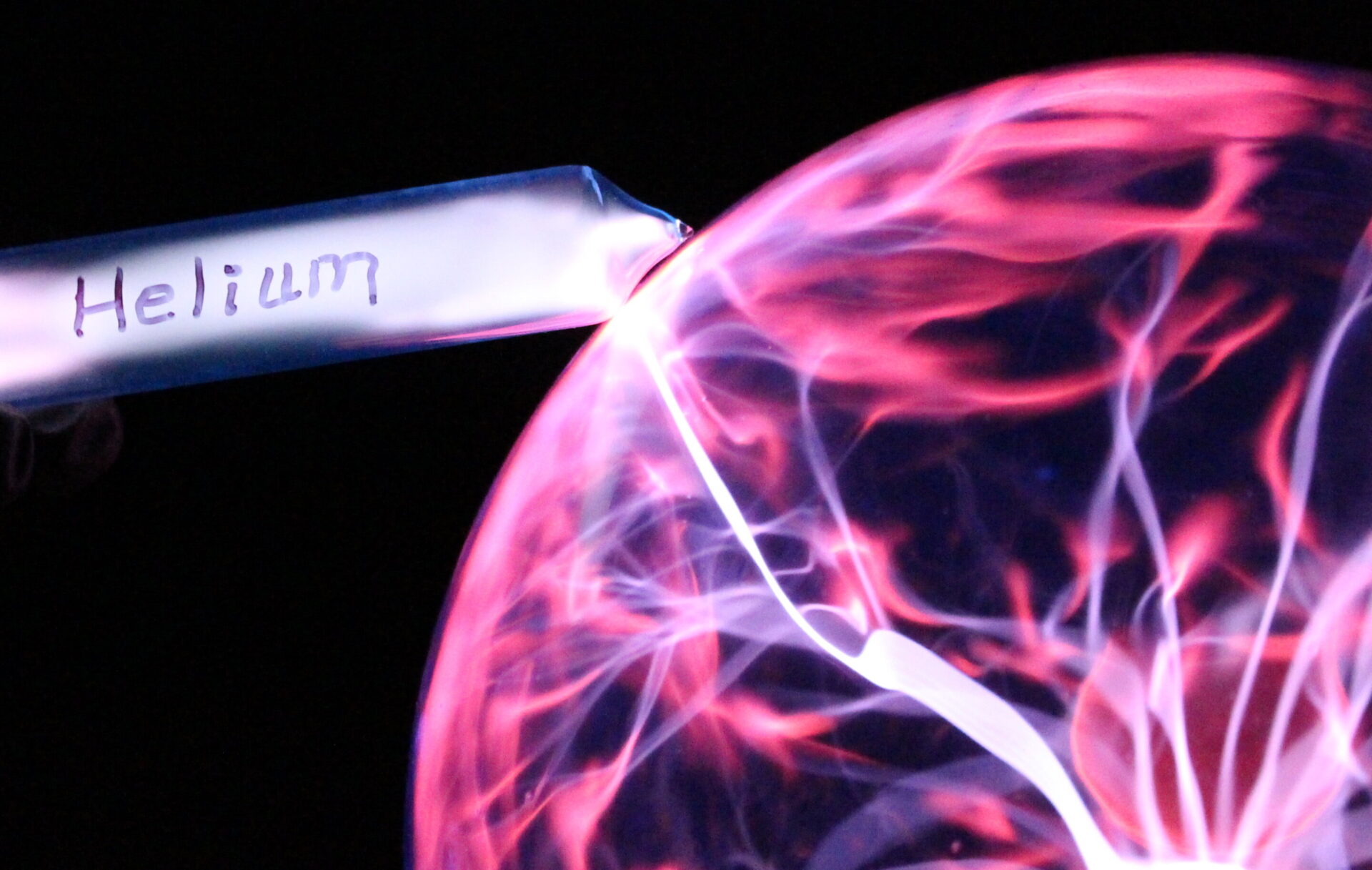
via CORTICAL LABS
The future of computing includes biology says an international team of scientists
The time has come to create a new kind of computer, say researchers from John Hopkins University together with Dr Brett Kagan, chief scientist at Cortical Labs in Melbourne, who recently led development of the DishBrain project, in which human cells in a petri dish learnt to play Pong.
In an article published today in Frontiers in Science, the team outlines how biological computers could surpass today’s electronic computers for certain applications while using a small fraction of the electricity required by today’s computers and server farms.
They’re starting by making small clusters of 50,000 brain cells grown from stem cells and known as organoids. That’s about a third the size of a fruit fly brain. They’re aiming for 10 million neurons which would be about the number of neurons in a tortoise brain. By comparison, the average human brain has more than 80 billion neurons.
The article highlights how the human brain continues to massively outperform machines for particular tasks. Humans, for example, can learn to distinguish two types of objects (such as a dog and a cat) using just a few samples, while AI algorithms need many thousands. And while AI beat the world champion in Go in 2016, it was trained on data from 160,000 games – the equivalent of playing for five hours each day, for more than 175 years.
Brains are also more energy efficient. Our brains are thought to be able to store the equivalent of more than a million times the capacity of an average home computer (2.5 petabytes), using the equivalent of just a few watts of power. US data farms, by contrast, use more than 15,000 megawatts a year, much of it generated by dozens of coal-fired power stations.
In the paper, the authors outline their plan for “organoid intelligence”, or OI, with the brain organoids grown in cell-culture. Although brain organoids aren’t “mini brains”, they share key aspects of brain function and structure. Organoids would need to be dramatically expanded from around 50,000 cells currently. “For OI, we would need to increase this number to 10 million,” says senior author Prof Thomas Hartung of Johns Hopkins University in Baltimore.
Brett and his colleagues at Cortical Labs have already demonstrated that biocomputers based on human brain cells are possible. A recent paper in Neuron showed that a flat culture of brain cells could learn to play the video game Pong.
“We have shown we can interact with living biological neurons in such a way that compels them to modify their activity, leading to something that resembles intelligence,” says Kagan of the relatively simple Pong-playing DishBrain. “Working with the team of amazing people assembled by Professor Hartung and colleagues for this Organoid Intelligence collaboration, Cortical Labs is now trying to replicate that work with brain organoids.”
“I would say that replicating [Cortical Labs’] experiment with organoids already fulfils the basic definition of OI,” says Thomas.
“From here on, it’s just a matter of building the community, the tools, and the technologies to realise OI’s full potential,” he said.
“This new field of biocomputing promises unprecedented advances in computing speed, processing power, data efficiency, and storage capabilities – all with lower energy needs,” Brett says. “The particularly exciting aspect of this collaboration is the open and collaborative spirit in which it was formed. Bringing these different experts together is not only vital to optimise for success but provides a critical touch point for industry collaboration.”
And the technology could also enable scientists to better study personalised brain organoids developed from skin or small blood samples of patients suffering from neural disorders, such as Alzheimer’s disease, and run tests to investigate how genetic factors, medicines, and toxins influence these conditions.
Original Article: Real AI will need biology: Computers powered by human brain cells
More from: Johns Hopkins University
The Latest Updates from Bing News
Go deeper with Bing News on:
Organoid intelligence
- Artificial Intelligence
The suit, which accuses the tech companies of copyright infringement, adds to the fight over the online data used to power artificial intelligence. By Katie Robertson A rap beef between hip-hop ...
- Artificial Intelligence
That could completely change the landscape for perinatal care and greatly improve outcomes, says the director of obstetric imaging at Beth Israel Deaconess Medical Center, especially in settings where ...
- Newly developed organoid model can be used to study thymus function
The Organoid group has now succeeded in developing a new system: TEC organoids, based on thymus tissue from mice. First author on the study Sangho Lim explains the advantage of these organoids ...
- Artificial Intelligence
Natural language processing (NLP) tools are software applications that can process and analyze text or speech in standard conversation format. The advantage offered by... eWeek has the latest ...
- Artificial Intelligence
The spending that the industry’s giants expect artificial intelligence to require is starting to come into focus — and it is jarringly large. By Karen Weise The National Highway Safety ...
Go deeper with Bing News on:
Biological computers
- UW Researchers Unlock Potential of 2D Magnetic Devices for Future Computing
Imagine a future where computers can learn and make decisions in ways that mimic human thinking, but at a speed and efficiency that are orders of magnitude greater than the current capability of ...
- Fertility Issues: Do Men Also Have A Biological Clock?
Dr Mishra says, “There isn't necessarily a "best" biological age for men to have children ... and miscarriage rates rise with age. Researchers used computer models to estimate ideal family planning ...
- Scientists Built a Working Human Brain Cell Out of Salt and Water
Scientists have long mimicked human synapses using conventional solid materials, but new research attempts to recreate using extremely basic ingredients: water and salt.By recreating human synapses ...
- Three Rensselaer Polytechnic Institute Faculty Members Honored by AAAS
Rensselaer Polytechnic Institute’s Boleslaw Szymanski, Ph.D., and Chunyu Wang, M.D. Ph.D., have been elected fellows of the American Association for the Advancement Science (AAAS). Steven Cramer, Ph.D ...
- Quantum fiber optics in the brain enhance processing, may protect against degenerative diseases
The effects of quantum mechanics—the laws of physics that apply at exceedingly small scales—are extremely sensitive to disturbances. This is why quantum computers must be held at temperatures colder ...









